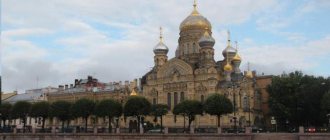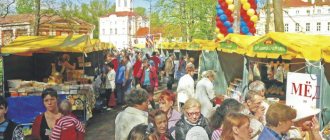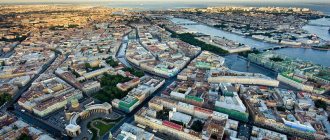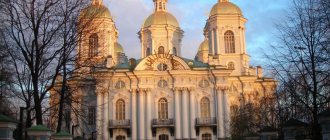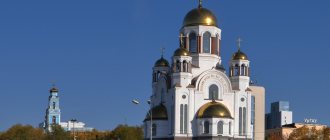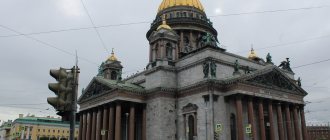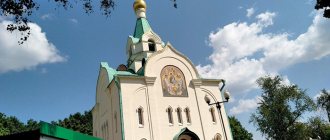The Smolensk Orthodox Cemetery is a large ancient necropolis of St. Petersburg, founded in the mid-18th century and located on an area of 51.7 hectares.
Over the long history of the necropolis, many famous and unknown burials, individual and fraternal, appeared in it. Here is the chapel-tomb of Blessed Xenia of St. Petersburg, there are three churches: Smolenskaya, Trinity and Resurrection.
Currently, at the Smolensk Orthodox Cemetery, only sub-burials are available within the areas where the graves of deceased relatives are already located.
How to get to the Smolensk Orthodox Cemetery?
Car from the center
From Nevsky Prospekt to Dvortsovy Proezd, Dvortsovy Bridge, then to the embankment. Makarova, emb. Smolenka river and st. Kamskaya, to the cemetery, which is 600 m away.
Car with WHSD
From the WHSD (29th km) turn right onto Ave. Krusenstern and emb. Makarova, then right again, onto Ave. KIM and emb. Smolenka River. Then to the Smolensky Bridge and lines 16 and 17 of Vasilyevsky Island. After 500 m, turn right onto Maly Prospekt of Vasilievsky Island, to the entrance to the necropolis, which is 500 m away.
Metro
The bus to the Smolensk Orthodox Cemetery leaves from the station. metro station "Vasileostrovskaya". By bus No. 47, 100 you need to go to the stop “24, 25 lines of Vasilievsky Island” (3 stops). Transport stops near the entrance to the cemetery.
Features of the Smolensk cemetery
Several cemeteries located in the central part of Vasilyevsky Island are united under the name Smolensk Cemetery:
- Orthodox;
- Armenian-Gregorian;
- Lutheran;
- Dekabristov Island.
Smolensk Cemetery in St. Petersburg
Each of them has its own unique appearance and history. Back in the eighties of the last century there were ruins here and these places were notorious among the townspeople. But since the beginning of 2000, the cemetery began to revive.
History of origin
Spontaneous burials on Vasilyevsky Island began long before the official mention (1738) of the cemetery, since this part of the city was often cut off from the center by bad weather. As a rule, residents were buried near their place of residence.
About the posthumous fate of the soul:
It is not known exactly when the saint was born and died, but it happened in the 18th century. She lived to be 71 years old and became a widow at 26. After this sad event, she labored as a holy fool until her death. She wandered around St. Petersburg in a man's dress, calling herself by the name of her deceased husband. Only when they addressed her: “Andrei Petrovich!” did she respond.
Blessed Xenia of Petersburg
At first, people came to look at her, and then they got used to it and even fell in love with Xenia, seeing a saint in her. The street where she lived was nicknamed Andrei Petrovich Street. City merchants considered it an honor when the holy fool took something from them. Ksenia was also respected by the cab drivers. Seeing the saint, they vied with each other to offer her their services. It was believed that whoever was lucky enough to carry Ksenia at least a few meters would succeed in the matter.
It is known how Ksenia took part in the construction of the stone Smolensk Church. Construction methods were like this back then. When the walls were raised, then the masons as a whole team carried bricks and scaffolding higher. And only then did they continue laying. At night, when the tired masons were sleeping, Ksenia lifted the bricks and stacked them on the scaffolding. The next morning, the workers discovered them, but could not understand how they got there until they tracked down their secret assistant.
Rumor spread throughout the area that such a godly deed as the construction of a church was in the hands of the saint of God. By that time, Ksenia’s popularity had become nationwide. Her words were believed, her instructions were followed. People loved her very much - she was insightful and helped many. And now she doesn’t refuse anyone if they really ask her for something.
Chapel of Xenia of Petersburg
When Xenia the Blessed died, she was buried at the Smolensk cemetery. The earthen burial mound was dismantled by the people. Then a tin mug was attached to the grave and with funds collected in this way, by the mid-19th century, a stone chapel of Blessed Xenia was built over her grave. It has become a popular place of pilgrimage. People from all over the city came here to ask for help in troubles and adversities.
- Ksenia Petersburgskaya: how to get to the chapel, opening hours
Chapel of Blessed Xenia, St. Petersburg
In the 1960s, during the period of regular persecution of the church, Xenia’s grave was walled up. A platform was built over it, and the chapel itself was given over to a shoemaker's workshop. But, as they say, Ksenia did not let them drive in a single nail. The shoemakers worked as if in a quagmire, everything fell out of their hands. When nothing came of the shoemaker's workshop, they made a sculpture workshop in the chapel. But this idea also failed. They lock the workshop, and in the morning they find only broken shards.
In 1988, Ksenia was canonized. During her life, she tried to help everyone. And after death, the saint does not leave people who turn to her without consolation.
The “heyday” of the necropolis
In 1836, it was decided to increase the territory of the cemetery. To implement this project, the council of St. Catherine’s Church purchased land owned by State Councilor Kireyev. As a result, the total area of the necropolis was increased to 15 hectares. A book recording those buried in 1912-1919 has survived to this day. Having studied this document, we can conclude that in one year the Smolensk Lutheran cemetery in St. Petersburg increased by no less than 350 new graves. In total, according to experts, about 25-30 thousand people were buried in this necropolis.
An ancient necropolis for non-believers in St. Petersburg
Until the events of the 1917 revolution, the attitude towards foreigners in Russia was special. Specialists from various fields and scientists from European countries were held in high esteem and were lured to work and move to Russia in every possible way; it was also prestigious to marry a foreigner of worthy origin. As a result, entire families of Germans, French and English immigrated to our country, and many remained here forever. What is important is that foreigners retained their status, and sometimes it was even easier for them to gain public recognition or a high position than for “locals.” Such visitors were not even required to accept Orthodoxy, regardless of status; Europeans were allowed to maintain their faith and not hide their religious beliefs. It is for this reason that in 1747, by order of the Synod, the organization of the first necropolis in St. Petersburg for non-Orthodox burials began. This is how the Lutheran Smolensk cemetery appeared in the south of the Dekabristov Island, which received its name in honor of the Smolenka River, which flows nearby.
History[edit]
At the beginning of its existence, the cemetery bore a toponymic name - “on Vasilyevsky Island near the Chernaya Rechka”, and occupied an area of about 4.5 hectares. Over time, it has grown noticeably, and the area of the modern Smolensk cemetery is 51.7 hectares.
The necropolis became a resting place for both ordinary people and honored figures of science and art. Over the years, the number of burials grew steadily, and the gradually increasing territory of the churchyard was divided into several zones. The plots of the highest categories were located near the church and were distinguished by good soil quality and cleanliness. Sites were created here for burials of members of the Academy of Sciences, the Academy of Arts, the Alexandrinsky and Mariinsky Theaters, the Mining Institute, etc. Sites of lower categories, with muddy soil, were intended for free burials.
In the pre-revolutionary period of Russian history, the Smolensk Orthodox cemetery was the largest in the city - by the 20th century, about 700-800 thousand burials were made on its land. In 1938, the cemetery was closed, but during the blockade they began to bury people here again. Military men and townspeople who died of hunger or died from shelling were brought here.
In the late 1980s, repair and restoration work was carried out at the cemetery, as a result of which several large areas were landscaped and more than 10 ancient monuments were restored.
Among the celebrities - famous people for whom this graveyard became the last refuge - A. S. Pushkin’s nanny Arina Rodionovna, poet Alexander Blok, landscape painter A. I. Kuindzhi, the first grave of Taras Shevchenko was also located here. Famous artists, writers, and scientists are buried in the modern Smolensk cemetery. Director A. O. Balabanov, backing vocalist of the Kino group G. K. Guryanov, and ballerina Olga Zabotkina are buried here.
By this time, the cemetery had acquired the status of semi-closed; mostly honored people, representatives of the art world, and celebrities were buried here.
Blessed Xenia of Petersburg
The Smolensk cemetery is also famous for the chapel of St. Xenia the Blessed, famous throughout the city, the intercessor and guardian of St. Petersburg. And many legends are also associated with the name of this patroness.
So, according to one of them, a young girl Ksenia, having buried her husband, distributed everything she had to the poor, put on the deceased’s coat and became insane. Both in the heat and in the cold, she wandered through the city streets and said all sorts of crazy things to passers-by. But it soon became clear that everything Ksenia said had a deeper meaning. She had the gift of clairvoyance.
After Ksenia died, people began to come to the madwoman’s grave at the Smolensk cemetery. And soon a chapel was built in her honor. This church did not close even during Soviet times. People believe that if you walk around the church three times, while thinking about your innermost thoughts, then the Blessed Xenia will fulfill your wish. This is probably why you can often find suffering lovers there.
Who was buried in a non-Orthodox necropolis?
The place for organizing the burials of “foreign foreigners of other faiths” was not chosen by chance. Vasilievsky Island, where many visitors lived at that time, is located very close. Since a significant number of foreign families permanently residing in St. Petersburg were Germans, the definition of this nationality became in some way synonymous with the word “foreigner.” For this reason, the Smolensk Lutheran cemetery was often called and is called today “German”. In fact, representatives of various faiths were buried here, among whom were people of various nationalities. The original plan for the cemetery was drawn up by the architect Trezzini. Burials in this necropolis were in most cases carried out with special chic and according to all the rules of that era, since most often famous, respected and wealthy people found their final refuge here. Family crypts, sculptural compositions and massive, lavishly decorated tombstones are a common sight in the Smolensk churchyard.
Official closure and WWII years
The necropolis was closed for mass graves in 1939. But, despite this fact, until the middle of the 20th century, single burials were carried out here. From this moment the story of the decline of the famous cemetery begins. Some of the most valuable tombstones were moved to the territory of the necropolis of the Alexander Nevsky Lavra, while the remaining graves began to gradually be overgrown with grass, and their monuments began to deteriorate and collapse. During the Great Patriotic War, the Lutheran Smolensk Cemetery also received Orthodox deceased. A mass grave for soldiers of the Leningrad Front and an unusual children's burial were organized here. On May 9, 1942, in one of the kindergartens in Leningrad, children and their teachers went for a walk; the entire group and staff of the institution died under enemy artillery fire. The children were buried here, in a large common grave.
Saint Petersburg
59° 56.3206 ′N, 30° 19.5213 ′E 59.93868N, 30.32536E 59°56′19.23″N, 30°19′31.28″E
- Map
- Notes 1317
- Photos 38,029
Links from experienced people
You can follow all new publications on any country or city using the feeds on your personal page, as well as using an RSS subscription. More details
- in My feeds
Use this code to insert a link to this destination into the text of a travel note, advice, blog post or forum post on Turbine. More details
This list includes authors who have received the highest ratings for materials about St. Petersburg.
Add the user as a friend if you want to follow his new materials, statuses and messages on the forums. If you just want to save the user’s data so as not to search for him again in the future, add him to your contacts .
Shrines[edit]
Church of the Smolensk Icon of the Mother of God[edit]
- the relics of the blessed Xenia of St. Petersburg (in the chapel)
- Smolensk image of the Mother of God Hodegetria, which is a copy of the miraculous icon located in Smolensk (in the temple)
- a list of the especially revered ancient icon of the Mother of God “Merciful”, or “It is Worthy to Eat”, given to the temple with the blessing of Metropolitan Gregory (Chukov) of Leningrad and Novgorod in 1950 (in the temple)
- venerated image of St. ap. and ev. John the Theologian of the era of Peter I (in the temple)
Prison cemetery
The Smolensk cemetery of St. Petersburg can be called almost the same age as the city on the Neva, because it appeared simultaneously with its emergence on the pages of history and was constantly growing, acquiring new secrets and new portions of mysticism. Initially, this was a burial place exclusively for dead prison prisoners, who were buried in chains. Only in 1738 did it receive the status of a city cemetery. Now the territory of this most ancient St. Petersburg necropolis occupies about 50 hectares and contains many intriguing and mysterious stories.
Flood
At the end of 1824, a flood hit the Smolensk cemetery. All the fences were demolished, the crosses were washed away, the burial places themselves were covered with earth so that it was almost impossible to find them. After the flood, many were unable to find the graves of their loved ones. The flood destroyed the entire archive located in the church; only the parish books, which the priests kept at home, were preserved. The Church of the Archangel Michael was destroyed almost to the ground. As a result, it had to be demolished, since the building could no longer be restored. During the flood, three old women even drowned because they were unable to escape.
In short, the entire cemetery was thrown into complete disarray and suffered enormous losses. A lot of time and effort was spent removing and restoring everything. However, many burials remained unfound. For example, the burial of the Knights of Malta.
Smolensk cemetery at the end of the 19th – beginning of the 20th century
Officially, until February 1, 1919, the necropolis belonged to the parish of the Lutheran Church of St. Catherine. The Church Council has always invariably taken care of the improvement of the cemetery territory and maintaining proper order there. In 1882, for example, a list of monuments that were to be restored or replaced was even compiled. In total, more than one and a half thousand tombstones were included in this list. Those that were especially badly damaged were described in detail and kept in the church. In 1860, the church council officially responded to the Commission’s request for the establishment of cemeteries regarding the presence of buildings and gravestones from the 18th century on the territory of the necropolis. According to this document, at that time there were 83 tombstones and 5 architectural monuments of the specified period on the territory of the churchyard. On February 1, 1919, the Lutheran Smolensk cemetery was nationalized and transferred to the department of the Commissariat for Internal Affairs.

